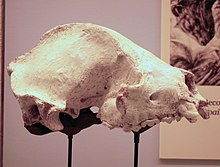Ailuropoda microta
| Ailuropoda microta Temporal range: Late Pliocene to Early Pleistocene | |
|---|---|

| |
| Scientific classification | |
| Domain: | Eukaryota |
| Kingdom: | Animalia |
| Phylum: | Chordata |
| Class: | Mammalia |
| Order: | Carnivora |
| Family: | Ursidae |
| Genus: | Ailuropoda |
| Species: | †A. microta |
| Binomial name | |
| †Ailuropoda microta | |
Ailuropoda microta is the earliest known ancestor of the giant panda. It measured 1 m (3 ft) in length; the modern giant panda grows to a size in excess of 1.5 m (5 ft). Wear patterns on its teeth suggest it lived on a diet of bamboo, the primary food of the giant panda. The first discovered skull of the animal in a south China limestone cave is estimated to be 2 million years old.[3] The skull found is about half the size of a modern-day giant panda, but is anatomically very similar. This research suggests that the giant panda has evolved for more than 3 million years as a completely separate lineage from that of other bears.
References
- ^ Pei, Wen-chung (1962). "Guǎngxī liǔchéng jù yuán dòng jí qítā shāndòng de dì sì jì bǔrǔ dòngwù" 广西柳城巨猿洞及其他山洞的第四纪哺乳动物 [Quaternary Mammals from the Liucheng Gigantopithecus Cave and Other Caves of Kwangsi] (PDF). Vertebrata PalAsiatica. 6 (3): 211–218.
- ^ Pei, Wen-Chung (1963). "Quaternary Mammals From the Liucheng Gigantopithecus Cave and Other Caves of Kwangsi" (PDF). Scientia Sinica. 12 (2): 221–229. Archived from the original (PDF) on 2017-08-21. Retrieved 2017-07-20.
- ^ Jin, Changzhu; Russell L. Ciochon; Wei Dong; Robert M. Hunt Jr.; Jinyi Liu; Marc Jaeger & Qizhi Zhu (2007-06-26). "The first skull of the earliest giant panda". Proceedings of the National Academy of Sciences. 104 (26): 10932–10937. Bibcode:2007PNAS..10410932J. doi:10.1073/pnas.0704198104. PMC 1904166. PMID 17578912.
